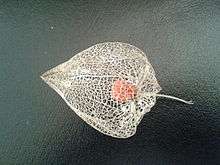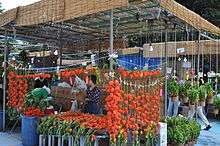Physalis alkekengi
| Physalis alkekengi | |
|---|---|
 | |
| Physalis alkekengi fruit with the red husk | |
| Scientific classification | |
| Kingdom: | Plantae |
| (unranked): | Angiosperms |
| (unranked): | Eudicots |
| (unranked): | Asterids |
| Order: | Solanales |
| Family: | Solanaceae |
| Genus: | Physalis |
| Species: | P. alkekengi |
| Binomial name | |
| Physalis alkekengi L. | |
| Synonyms[1] | |
| |
Physalis alkekengi (bladder cherry, Chinese lantern,[2] Japanese-lantern,[3] strawberry groundcherry,[4] or winter cherry;[2]) is a relative of P. peruviana (Cape gooseberry). It is easily identifiable by the large, bright orange to red papery covering over its fruit, which resembles paper lanterns. It grows naturally in the regions covering Southern Europe to South Asia and Japan. It is a perennial herbaceous plant growing to 40–60 cm tall, with spirally arranged leaves 6–12 cm long and 4–9 cm broad. The flowers are white, with a five-lobed corolla 10–15 mm across, with an inflated basal calyx which matures into the papery orange fruit covering, 4–5 cm long and broad.
Cultivation

It is a popular ornamental plant, though it can be invasive with its wide-spreading root system sending up new shoots some distance from where it was originally planted. In various places around the world, it has escaped cultivation.[5]
Traditional uses
The dried fruit of P. alkekengi is called the golden flower in the Unani system of medicine, and used as a diuretic, antiseptic, liver corrective, and sedative.[6]
Chemical constituents
Like a number of other species in the genus Physalis, it contains a wide variety of physalins.[7][8][9] When isolated from the plant, these have antibacterial[10] and leishmanicidal[11][12] activities in vitro.
It also contains caffeic acid ethyl ester, 25,27-dehydro-physalin L, physalin D, and cuneataside E.[13]
Cultural significance

In Japan, its seeds are used as part of the Bon Festival as offerings to guide the souls of the deceased. Also, an annual market is dedicated to the flower called hōzuki-ichi, which occurs in Asakusa around Sensō-ji every year on July 9 and 10.
References
| Wikimedia Commons has media related to: |
- ↑ The Plant List
- 1 2 "USDA GRIN Taxonomy, entry for Physalis alkekengi".
- ↑ "BSBI List 2007". Botanical Society of Britain and Ireland. Archived from the original (xls) on 2015-02-25. Retrieved 2014-10-17.
- ↑ "Physalis alkekengi". Natural Resources Conservation Service PLANTS Database. USDA. Retrieved 2015-10-01.
- ↑ "1. Physalis alkekengi Linnaeus". Flora of China.
- ↑ Rasheed N.M.A., Shareef M.A., Ahmad M., Gupta V.C., Arfin S., Shamshad A.K. "HPTLC finger print profile of dried fruit of Physalis alkekengi Linn." Pharmacognosy Journal 2010 2:12 (464–469).
- ↑ Matsuura, T; Kawai, M; Makashima, R; Butsugan, Y (1970), "Structures of physalin A and physalin B, 13,14-seco-16,24-cyclo-steroids from Physalis alkekengi var. Francheti.", Journal of the Chemical Society. Perkin transactions 1, 5: 664–70, doi:10.1039/j39700000664, ISSN 0300-922X, PMID 5461642
- ↑ Qiu, L; Zhao, F; Jiang, Zh; Chen, Lx; Zhao, Q; Liu, Hx; Yao, Xs; Qiu, F (Apr 2008), "Steroids and flavonoids from Physalis alkekengi var. franchetii and their inhibitory effects on nitric oxide production.", Journal of Natural Products, 71 (4): 642–6, doi:10.1021/np700713r, PMID 18348534
- ↑ Kawai, M; Yamamoto, T; Makino, B; Yamamura, H; Araki, S; Butsugan, Y; Saito, K (2001), "The structure of physalin T from Physalis alkekengi var. franchetti.", Journal of Asian natural products research, 3 (3): 199–205, doi:10.1080/10286020108041391, ISSN 1028-6020, PMID 11491395
- ↑ Silva, M.T.G.; Simas, S.M.; Batista, T.G.; Cardarelli, P.; Tomassini, T.C.B. (2005). "Studies on antimicrobial activity, in vitro, of Physalis angulata L. (Solanaceae) fraction and physalin B bringing out the importance of assay determination". Memorias do Instituto Oswaldo Cruz. 100: 7. doi:10.1590/s0074-02762005000700018.
- ↑ leishmanicidal Archived May 15, 2010, at the Wayback Machine.
- ↑ Choudhary M.I., Yousaf S., Ahmed S., Samreen, Yasmeen K., Atta-ur-Rahmang "Antileishmanial physalins from Physalis minima" Chemistry and Biodiversity 2005 2:9 (1164-1173).
- ↑ YUAN Ye, XU Nan, BU Xian-kun, ZHAN Hong-li, ZHANG Meng-meng Chemical constituents of Physalis alkekengivar. franchetii (Ⅱ) "Chinese Traditional and Herbal Drugs" http://en.cnki.com.cn/Article_en/CJFDTOTAL-ZCYO201012005.htm (Liaoning University of Traditional Chinese Medicine, Dalian 116600, China).